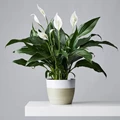
The jade plant is a popular succulent houseplant that is native to South Africa and requires warm and dry climate conditions to grow happily. Their thick woody stems and oval-shaped leaves give them the appearance of a miniature tree. When grown indoors they can grow as high as three feet tall. They also live for a long time and sometimes can live for 100 years when cared for properly.
The reason behind the jade plant’s popularity in homes and offices is that many people consider it to be a symbol of good luck. However, you should practice caution while choosing a place to plant your jade plant either indoors or out in your garden if you have pets because its leaves can be poisonous for your cats and dogs.
Sunlight and Temperature
Jade plants love soaking in the sun and require at least 6 to 8 hours of bright sunlight every day. Keep your young jade plant in a place that receives bright and indirect sunlight. As your plant grows and matures, then you can start placing them in a place that receives direct sunlight.
Jade plants can become stunted and appear leggy when they don’t have enough access to sunlight. On the other hand, too much contact with direct sunlight can scorch the leaves of a young jade plant or cause a mature jade plant to develop red tips. As the temperature starts to cool down then you can move your jade plant into direct sunlight.
18 to 24°C is the perfect indoor temperature for jade plants during the day and between 10 to 13°C at night. Jade plants are not tolerant to frost. Therefore, if you grow your jade plant outdoors then bring it inside once the temperatures start to dip. Also, make sure that during winters your plant is kept away from windows and drafty areas because being exposed to cold temperatures can cause the jade plant to lose some leaves.
Irrigation
Improper watering can cause a lot of issues in a jade plant. In spring and summer, the jade plant is actively growing. Therefore, it requires more water than at any other time of the year. However, you must ensure that your jade plant is not overwatered. Try watering the jade plant deeply and waiting until the soil is almost dry to water again.
The soil should be moist and not soaking wet once you have finished watering the plant. During the seasons of autumn and spring, the plant becomes dormant and stops growing. So, the plant won’t need much water at this time. Allow the soil to completely dry before watering it again. You should also avoid watering the leaves of the jade plant while watering because this can expose them to rot in a humid environment.
Pot
While potting a jade plant either uses a terracotta or unglazed clay pot because they allow excess moisture to evaporate through its walls and ensure that the plant is not waterlogged. You should also pot your plant in soil that is porous and doesn’t retain water.
Fertilize
It is important that you provide the jade plant with all necessary nutrients in the form of fertilizers. You can use a diluted mix of standard liquid houseplant fertilizer or a fertilizer designed for cacti and succulents. Feed a young succulent plant annually right before the growing season.
Pest Management
Jade plants attract a wide variety of pests. The most common jade plant pests are mealybugs, scale, or spider mites. Since jade plants are very sensitive to chemical insecticides, the best way to deal with the infestation is by wiping the insects off with a cotton ball soaked in rubbing alcohol.
Repotting
Repotting a plant every few years helps a plant grow properly. Since repotting encourages the growth of a jade plant, therefore, you must repot a young jade plant every 2 to 3 years and repot a mature jade plant every 4 to 5 years.











